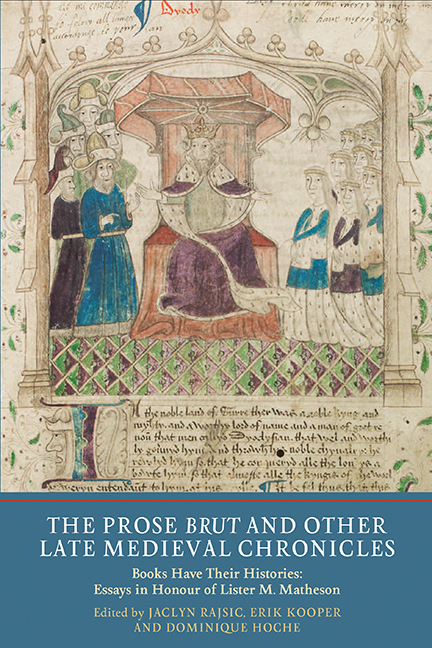 The Prose Brut and Other Late Medieval Chronicles
The Prose Brut and Other Late Medieval Chronicles Book contents
- Frontmatter
- Dedication
- Contents
- List of Plates
- List of Contributors
- Acknowledgements
- Curriculum Vitae of Lister M. Matheson
- Introduction
- A Memoir: The Whole Haggis: Lessons From the Work of Lister M. Matheson
- Part I Uses of History
- Part II The Prose Brut
- Part III Receptions and Afterlives of Late Medieval Chronicles
- Index of Manuscripts Cited
- General Index
- Tabula in Memoriam
Introduction
Published online by Cambridge University Press: 05 July 2016
- Frontmatter
- Dedication
- Contents
- List of Plates
- List of Contributors
- Acknowledgements
- Curriculum Vitae of Lister M. Matheson
- Introduction
- A Memoir: The Whole Haggis: Lessons From the Work of Lister M. Matheson
- Part I Uses of History
- Part II The Prose Brut
- Part III Receptions and Afterlives of Late Medieval Chronicles
- Index of Manuscripts Cited
- General Index
- Tabula in Memoriam
Summary
London, Lambeth Palace Library, MS 84, the first folio of which appears on the cover of this book, was a manuscript very close to Lister Matheson's heart. Although he described the manuscript with a critical eye as having a ‘poorly drawn half-page frontpiece’, Matheson had been working with great diligence and affection on Lambeth 84 for nearly three decades: he mentioned it many times in his classroom lectures on the Prose Brut and the History of the Book, and had even managed to use it as an example in his course on Chaucer and occasionally in his famed class on Medieval Drama. Indeed, he had been planning to write a monograph about it; thus far he had presented four papers and published an essay on the Arthurian stories in the chronicle. He was particularly struck by the physical composition of the chronicle itself: the amount of supplementary material written in the margins was ‘unparalleled’ and there was a noticeably large number of small slips of vellum interspersed in the manuscript. In the classroom, his attention to detail, combined with a thorough knowledge of medieval historical and literary texts and his skill as a thrilling storyteller, made him a fascinating and entertaining teacher: we knew that everything in his lecture would sooner or later connect with everything else, with the clarity and intellectual satisfaction of a Venn diagram. (Matheson drew such diagrams on the board when teaching complex ideas and theories, and used the overlapping circles to illustrate relationships between characters in medieval texts.) We understood that to be proper medievalists, we must grasp the content of a text as well as the material circumstances in which that text was created. One of the most difficult skills Matheson taught his students was how to glean a solid conclusion from what first appeared to be a complete lack of information. No detail was ever insignificant: he showed us how to extrapolate seminal discoveries from the smallest elements.
An exploration of the late Professor Lister M. Matheson's influence as a scholar and a teacher lies at the heart of this collection.
- Type
- Chapter
- Information
- The Prose Brut and Other Late Medieval ChroniclesBooks have their Histories. Essays in Honour of Lister M. Matheson, pp. 1 - 6Publisher: Boydell & BrewerPrint publication year: 2016
